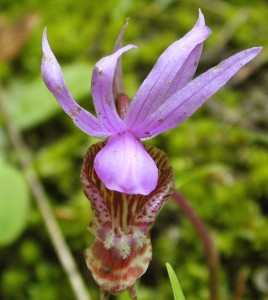With 20,000 to 30,000 species worldwide, the Orchid Family competes with the Aster Family for having the most species. Orchids occur all over the world, including the Arctic Circle, but most grow in the tropics. About 40 species of orchids grow in the temperate zone.
Tropical orchids are often quite showy, but most of the temperate zone orchids are very small and often have inconspicuous flowers. The plants generally have simple leaves with parallel veins. Orchids have 3 petals and 3 sepals which are often called tepals.
 Orchids flowers are bilaterally symmetrical with 5 tepals above. The middle one of these is usually broader than the other 5 tepals. A sixth, lower tepal is usually larger and more brightly colored than the others and is modified into a lip or pouch. The lip is sometimes spurred. The stamen are fused with the pistil and stigma to form a column. The column is often hidden in the flower, but sometimes is seen sticking up in the throat of the orchid.
Orchids flowers are bilaterally symmetrical with 5 tepals above. The middle one of these is usually broader than the other 5 tepals. A sixth, lower tepal is usually larger and more brightly colored than the others and is modified into a lip or pouch. The lip is sometimes spurred. The stamen are fused with the pistil and stigma to form a column. The column is often hidden in the flower, but sometimes is seen sticking up in the throat of the orchid.
Temperate orchids grow in moist, humus-rich soil. They often have mycorrhial roots. The mycorrhial roots of some species enable them to be saprophytic – using specialized fungi to harvest sugars. The stems and flowers of the saprophytic orchids are red or white and they have no leaves.
The fruit of orchids is usually a 1-chambered capsule with very numerous tiny, dust-like seeds.
Economically, orchids are important to florists and horticulturists. Vanilla extract comes from the tropical orchid, Vanilla Plant.
There is information about changes in the Orchid Family below the photo gallery.
This gallery features 14 species from the Orchid Family
[Not a valid template]
Information about changes in the Orchid Family.
Note 1: The orchid-group known as Rein-orchids were formerly all in the genus Habenaria. The name Rein-orchid comes from the strap–shaped spur and petals. This genus has now been divided into two: 1) Piperia with sepals and petals that spread out and basal leaves that usually wither before blooming. These sometimes grow in dry areas. 2) Platanthera with 2 upper petals and a sepal that overlap to form a hood and leaves on the stem that are retained during flowering. These grow only in wet, boggy areas and are sometimes called Bog-orchids.
Note 2: The orchids are considered a relatively primitive flower; the Aster family is the most recent and most developed family. Both are highly successful.
